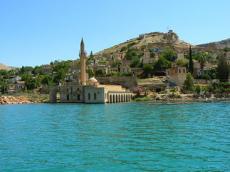|
|
TODAY.AZ / Weird / Interesting
Halfeti - a land of black roses
13 January 2014 [13:20] - TODAY.AZ
 Viewers of one of Turkey’s most popular soap operas are mesmerized not by the beauty of the protagonists or the intricate plot but by Halfeti, the breathtakingly beautiful town in which it is set.
Viewers of one of Turkey’s most popular soap operas are mesmerized not by the beauty of the protagonists or the intricate plot but by Halfeti, the breathtakingly beautiful town in which it is set.Located along the banks of the river Euphrates in the southeastern Turkish district of Shanliurfa, Halfeti was partially flooded in 1999 to create the Birecik dam.
Viewers of the Turkish TV series, titled “Karagul” (Black Rose), see characters coming in and out of their old stone houses, looking pensively into the bright blue waters of the lake.
Like an underwater museum, the flooded half of Halfeti can be clearly seen under the crystal waters of the lake, roofs of sunken houses and walls surrounding a garden, hinting at its rural past and only adding to the town’s beauty.
Until the area was flooded in 1999, the people lived from fishing in the Euphrates and farming on the riverbank, especially growing peanuts and the area’s famous black roses (hence the title of the soap). Then the waters came and “new” Halfeti was built.
Halfeti now attracts nearly two hundred thousand visitors a year from around the world, most of them arriving in spring and autumn - but avoiding the searing heat of the summer. Trekking and water-sports are offered in the town where there is also a quad bike track. Restaurants serve traditional meat and fish dishes. However, accommodation is limited since new buildings are not welcomed by the local community.
The town is also a member of the “slow city” movement, “Cittaslow,” that advocates a cultural shift toward slowing down the pace of life.
Halfeti is one of the “unique” members of this movement thanks to its “substantial history, distinctive architectural identity and cultural diversity,” says 30-year-old Halfeti native Nihat Özdal, who coordinated the project for the town’s “slow city” membership.
“Halfeti is a blessed mixture of Bodrum (a coastal town on the Aegean) and Mardin (southeastern Turkish city famous for its ancient architecture). You cannot distinguish, here in Halfeti, where the water ends and where life begins,” says Özdal.
Adjacent to the town is Rumkale, an ancient fortress first built by Assyrians, later occupied by various Byzantine and Armenian warlords during the Middle Ages. It once served as the seat of an Armenian patriarch. The Memluks of Egypt, Seljuks and finally Ottomans retained the fortress securing Anatolia under Islamic rule.
Bordering Halfeti, is the uninhabited village of Savasan Koy, flooded as part of the same development project, the Southeastern Anatolia Project, which includes a chain of 21 hydroelectric and irrigation dams bringing water to the poor arid southeast region of Turkey. To the visitors’ amazement, only half of a minaret seen above the water level in Sava?an Koy offers an eerie reminder of what the dam took away from the people’s life around the lake.
/HurriyetDailynews/
URL: http://www.today.az/news/interesting/129883.html
 Print version
Print version
Views: 2353
Connect with us. Get latest news and updates.
See Also
- 05 February 2025 [19:41]
Japan plans to negotiate with Trump to increase LNG imports from United States - 23 January 2025 [23:20]
Dubai once again named cleanest city in the world - 06 December 2024 [22:20]
Are scented candles harmful to health? - 23 November 2024 [14:11]
Magnitude 4.5 earthquake hits Azerbaijan's Lachin - 20 November 2024 [23:30]
Launch vehicle with prototype of Starship made its sixth test flight - 27 October 2024 [09:00]
Fuel prices expected to rise in Sweden - 24 October 2024 [19:14]
Turkiye strikes terror targets in Iraq and Syria - 23 October 2024 [23:46]
Kazakhstan supplied almost entire volume of oil planned for 2024 to Germany in 9 months - 23 October 2024 [22:17]
Taiwan reported passage of Chinese Navy aircraft carrier near island - 23 October 2024 [21:50]
Russia remains largest oil supplier to India
Most Popular
 Step by step, Pashinyan forces to fulfill Baku's conditions
Step by step, Pashinyan forces to fulfill Baku's conditions
 Destroyed cemeteries in Karabakh: Armenians have raised a question that incriminates them
Destroyed cemeteries in Karabakh: Armenians have raised a question that incriminates them
 Kazakhstan's report confirmed Baku's correctness. What will Moscow say now?
Kazakhstan's report confirmed Baku's correctness. What will Moscow say now?
 Azerbaijan advances solar power plant construction with UAE’s Masdar and SOCAR Green
Azerbaijan advances solar power plant construction with UAE’s Masdar and SOCAR Green
 Russian propagandists work hard on lies about the AZAL disaster
Russian propagandists work hard on lies about the AZAL disaster
 Armenian PM agrees not to deploy EU troops on border with Azerbaijan
Armenian PM agrees not to deploy EU troops on border with Azerbaijan
 OTS and Turkish Investment Fund discuss boosting economic cooperation
OTS and Turkish Investment Fund discuss boosting economic cooperation
